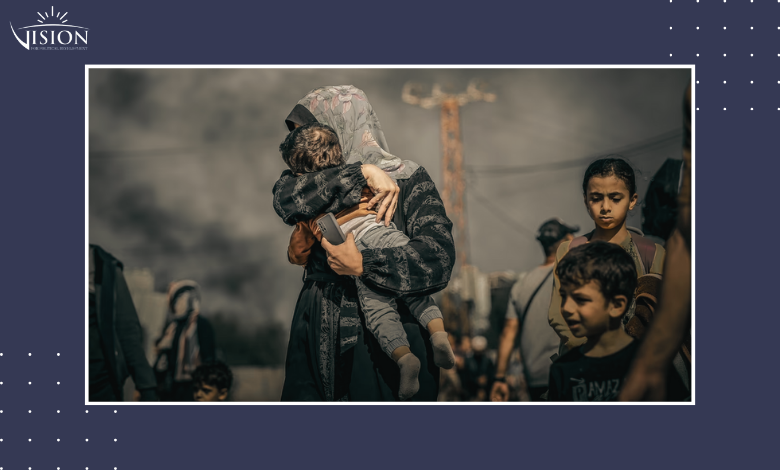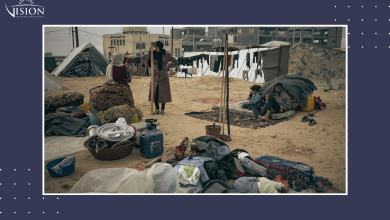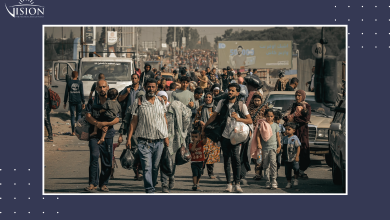Palestinian Motherhood in the Shadow of Genocide: Childbearing, amidst Fear, Hope, and Despair

In Palestinian society, motherhood can no longer be reduced to slogans of “reproduction as an act of resistance.” While this narrative dominated past decades, it oversimplified the reality: reproduction is not solely a political act but also a natural, life-affirming choice, especially since social and research-based realities show that fertility rates among Palestinians, as in all societies, are influenced by complex economic, educational, and psychological factors, and not by conflict alone.
The ongoing genocide in Gaza accompanied by destruction, starvation, and the collapse of essential life-support, health, and social infrastructures has reopened fundamental questions for women about the meaning of childbearing itself. In the context of genocide, motherhood has become a delayed or fear-laden choice, as many women have lost any sense of safety and stability, and daily life has turned into a struggle for survival.
In wartime, on the one hand, the Palestinian mother loses the meanings of hope, and her environment becomes a fragile space that tests the limits of her endurance. While on the other hand, procreation and motherhood in this context, becomes an act that goes beyond instinct, a form of expressing the desire to remain, to resist annihilation rather than merely a biological continuation of life.
Testimonies from Reality
Reflecting the sheer scale of the catastrophe, the Gaza Strip has witnessed an unprecedented collapse in birth rates. According to reports by the United Nations and the Ministry of Health, only 17,000 births were recorded in the first half of 2025, a staggering 41% decrease compared to the same period before the war.
Islam Abu Zeid (a pseudonym) says: “We got married a year before the war, and we were eagerly waiting for our first child. Fate willed that I became pregnant in April 2025.” She adds: “When we found out about the pregnancy, we were overwhelmed with joy, but only for a few minutes. My husband quickly slipped into a deep sadness. A few days later, he confessed that he did not want the baby; he did not want to bring a child into a war, or for the war.”
His reasoning was painful and devastating: “He did not want a deformed child, he did not want a starved child, he did not want to lose me in something that is euphemistically called childbirth, and he did not want to lose a child who could be killed by a missile.”
Islam continues: “We remained in a state of conflict and tension for nearly a month, he wanted to abort the fetus, and I was determined to keep it. Then one morning, I woke up to a stain of blood on my bed.” She adds: “At the field hospital, the doctors told me I was miscarrying. I fell into deep sadness and depression, and for a moment I felt that God was punishing my husband for rejecting the baby. But the truth was far more painful. When I recovered, my husband told me he had caused the miscarriage; he had given me medication that induces abortion.”
She concludes her story bitterly: “With the ongoing genocide and the spread of famine, I thanked God that I was no longer pregnant; in any case, I would probably have lost my baby to starvation or under the intensifying bombardment.”
Islam’s story is just one among hundreds of unreported accounts of women who have lost their freedom of choice, amid journalistic reports indicating that the miscarriage rate in Gaza has risen dramatically during the war. There are also dozens of women who have chosen to terminate their pregnancies “silently,” far from any statistics that could capture such experiences.
Alaa Rashid (a pseudonym), a social counselor in one of the displacement camps, speaks with painful candor: “I aborted my pregnancy. Yes, I fear for my children’s lives, and at the same time, I feared for the fetus, for its life, its hunger, its potential deformities. So I ended the pregnancy.”
Alaa, a mother of three, witnessed the horrors of the war alongside her children. She discovered her fourth pregnancy during the January 2025 ceasefire and rejoiced at the news, but her joy vanished with the collapse of the truce and the resumption of war on March 18, 2025, bringing back memories of displacement and starvation. She says: “I heard many stories of women who chose to abort or were forced to. So I decided to end my pregnancy. Continuing it felt like madness to me.”
Alaa continues her story: “I turned to a relative who works in the health sector with UNRWA. After several conversations, she helped me obtain medication used for abortion. I took the medication and ended the matter quietly, without anyone in my family or my husband’s family knowing.”
An Emotional Struggle
Dr. Raeda Abu-Ubaid, a specialist in developmental and social psychology, explains that “the horror of the war and genocide has driven women to make harsh decisions that contradict their nature, such as terminating a pregnancy or avoiding it altogether out of a deep fear of famine, or of bringing children into an environment surrounded by death, or out of fear of deformities.”
She notes that women in Gaza live under psychological pressure that exceeds human endurance. Bombardment, massacres, and the loss of loved ones all create a state of acute stress and constant anxiety. She adds: “Then comes the reality of famine, which has intensified many women’s desire to abort. When motherhood becomes intertwined with danger and loss, many choose to end their pregnancy as a psychological defense mechanism.”
Dr. Abu-Ubaid distinguishes between forced abortion due to clear medical reasons and what she calls “psychological abortion”, a decision born out of terror and fear in a reality that offers no basic conditions to protect a fetus. She continues: “This internal struggle is profound. Women are instinctively oriented toward motherhood, but the war has turned that instinct into a burden. It has placed them in an emotional battle between betraying motherhood or saving innocent lives from an even more horrific death. In both cases, there is immense pain, heavy silence, and an urgent need for psychological support, which is now entirely absent in Gaza.”
The Engineering of Starvation
In a statement published by The Guardian, Michael Fakhri, the UN Special Rapporteur on the Right to Food, said that Israel has “created a systematic mechanism for engineering mass starvation in Gaza,” describing it as “a crime against humanity.”
An official report published on the United Nations website also confirmed that famine resulting from conflict is a predictable political outcome, and that obstructing humanitarian access and using war as a tool to prevent food from entering constitute a deliberate use of starvation as a ‘weapon of war’.
Mrs. Bara’a Saydam says, “This war engineered through starvation has gnawed away at the fingernails of our dreams.” She adds: “My greatest dream was to become a mother. But with the first signs of pregnancy, fragments of terror and shards of famine appeared before me, along with an angelic face growing inside me. How can I search for an identity for that child in a tent?”
Bara’a openly declared her intention to abort the pregnancy, but she was met with rejection. She says: “Everyone stood against me; my mother, my aunts, my mother-in-law, my friends. They fought my desire and attacked me. They are not from the era of genocide and famine; no one is enforcing an engineered starvation upon them.” She describes how every morning confronts her directly with the decision to abort, especially as famine deepens and the world remains silent.
As for Rawand Al-Tatar, who married during the war, she had decided to delay pregnancy. But she was shocked to find herself pregnant despite her long-standing decision to avoid having children. She says: “I cried a lot. I wasn’t ready. I won’t hide that I thought about abortion, but I was met with a wall of rejection from my family.” She continues: “The decision to abort kept resurfacing as part of my nightly hallucinations, only to dissipate with the arrival of a new morning in which I am required to confront the horror of the war with all my strength.”
In another story, photographer Maryam Dabbash was exposed multiple times to significant amounts of toxic gas, the most recent exposure occurring just before her wedding. Still, she made sure to take folic acid to protect her fetus. She says: “Pregnancy wasn’t merely a biological matter; it was a rare moment of hope in a place where war steals everything.”
Despite severe food shortages, her husband tried to compensate by bringing her varied food items whenever he could, at extremely exorbitant prices.
She continues: “In the third month, I was seized by severe cramps. The doctor told me I needed an abortion due to multiple fetal deformities, the fetus had no limbs, no head, and no heartbeat.”
Absence of the Skull
In the context of genocide, Maryam’s case was not an anomaly. Fear of fetal deformities has become a genuine terror, especially after doctors in Gaza reported the birth of infants with horrific abnormalities, such as “complete absence of the skull”, cases they had never encountered throughout decades of medical practice. They linked these deformities to exposure to toxins and gases released by bombardment and explosives.
According to a Ministry of Health statement covering the period from January to June 2025, the health system in the Gaza Strip recorded 67 births with congenital anomalies out of approximately 17,000 births (around 0.39%, or 3.9 per 1,000 births).
Field data and independent reports indicate a rise in congenital malformations in 2025, although methodological inconsistencies exist in how such cases are documented and detected due to the extraordinary emergency conditions in Gaza.
The Ministry of Health points to several potential factors associated with the reported increase, including: malnutrition among pregnant women, shortages of medication, diagnostic tests, and clinics, exposure to toxins or emissions resulting from bombardment, and emergency births occurring under non-medical conditions.
According to the United Nations Population Fund (UNFPA), the birth rate in Gaza dropped by a staggering 41% in the first half of 2025 compared to 2022. More alarming still is that maternal mortality during pregnancy and childbirth has risen more than twentyfold compared to pre-war levels.
Decline in Births
The catastrophe is compounded by severe malnutrition. In August 2025, international organizations such as Save the Children and Action Aid reported that between 40% and 70% of pregnant and breastfeeding women suffer from malnutrition, endangering their own lives, the lives of their fetuses, and their ability to breastfeed their newborns.
According to the United Nations Population Fund (UNFPA) report on the situation in the occupied Palestinian territory, published in June 2025, maternal and newborn care has come to a complete halt due to shortages of fuel and medical supplies. This has left pregnant women, premature infants, and low-birth-weight newborns without any life-saving support.
The report documents a sharp decline in births, accompanied by rising maternal and newborn deaths, a stark reflection of the collapse of healthcare services and the dangerous conditions forcing women to give birth.
According to the Gaza Ministry of Health, only 17,000 births were recorded in the first six months of 2025, a shocking 41% decrease compared to the same period in 2022. The ministry also recorded a rise in miscarriages, with more than 2,600 women affected, and 220 pregnancy-related deaths occurring before delivery.
Ministry data further shows a sharp increase in premature births and low birth weight:
- More than 1,460 babies were born prematurely,
- More than 1,600 babies were born underweight,
- Over 2,500 infants were admitted to neonatal intensive care.
Newborn mortality also increased, including at least 21 infants who died on their first day of life.
Save the Children reported that 43% of pregnant and breastfeeding women who visited its clinics in Gaza during July were suffering from malnutrition. The organization added that some breastfeeding mothers expressed extreme despair and fear of death. Among 747 women examined during the first half of July, 323 women (43%) were found to be malnourished, a condition that can severely affect their ability to care for their children or maintain their pregnancies.
Profound Intellectual Transformations
Researcher Marihan Abu-Laban, a specialist in women and society, asserts in a private interview that the ongoing transformation of Palestinian feminist consciousness and motherhood instincts during the current genocide in Gaza represents one of the most severe shifts in modern Palestinian social history. The Gazan woman, who once saw reproduction as a patriotic and resilient act of resistance, no longer views childbirth as a symbol of survival but rather as a new possibility for loss and a threat to life itself.
Abu-Laban describes this shift as a “symbolic assassination of Palestinian motherhood,” explaining that women’s behaviour is no longer governed by the fear of death alone but by the fear of continuing life in a reality stripped of the conditions for human existence. She adds:
“This reversal in thinking is not a rejection of the idea of resistance or abandonment of the ethos of steadfastness and resilience that has formed the core of Palestinian identity. Rather, it is a direct result of a complex genocide targeting both the body and meaning simultaneously. When a woman is forced to fear reproduction, it means the war has surpassed the limits of bombardment and killing, reaching the deepest point of collective consciousness, the womb of life itself.”
Abu-Laban observes that genocide has not only destroyed Gaza’s physical infrastructure but also undermined the symbolic structure of Palestinian society, in which women have historically been the central pillar. Today, reproduction is conditioned by fear, and the womb, once a symbol of survival, has become a stage for existential anxiety.
She attributes this transformation to the convergence of overwhelming factors: food insecurity, intensified starvation, the absence of doctors, hospitals, and medical treatment, lack of infant formula, the collapse of healthcare systems, and the proliferation of images of mass child mortality. When a woman sees corpses of infants in the streets or witnesses a mother burying her children under rubble, the decision to reproduce becomes a painful act rather than a heroic one.
The researcher emphasizes that “the idea of reproduction as an act of resistance” is not merely a popular slogan but a fundamental pillar of the structure of the Israeli-Palestinian conflict, historically rooted in the equation of demographic warfare. Since the inception of the Zionist project, population density has been a central tool for consolidating territorial control. In response, Palestinians developed a counter-concept in which Palestinian births represented a sovereign act over geography and a guarantee for the continuity of national existence. However, the current genocide has disrupted this historical role, transforming motherhood into an experience of existential fear rather than an act of belonging and continuity.”
Conclusion
When a woman is forced to balance her life against that of a potential child, and when she is led to believe that childbirth is a burden rather than a promise, the war has penetrated the most sacred realm of human consciousness: a woman’s right to hope. Nevertheless, Abu-Laban cautions against interpreting this shift as a collapse in Palestinian steadfastness and resilience:
“What is happening today is an emergency caused by the environment of genocide, not a decline in national consciousness. Palestinian women have not lost their will to live; they have temporarily lost the tools to protect it.”
She adds that the gradual restoration of a sense of safety is sufficient to revive the spirit of women’s resistance that motherhood has historically embodied in the Palestinian experience. When basic living conditions are restored, women will reclaim their natural role as protectors of existence, and reproduction will once again become a symbol of resistance and an exercise of sovereignty over life itself.
Abu-Laban describes this phase as a “point of contact between instinct and politics.” The Palestinian mother no longer reproduces solely to fill a demographic gap but to assert her presence in the struggle for existence. When war forces her to halt reproduction, she does not retreat; rather, she expresses the depth of the collective wound inflicted upon the capacity for life itself. “This is not a female defeat but an open national wound.”
She sees the restoration of this resistant consciousness as beginning with the rebuilding of women’s existential security. When a woman feels her child will survive, she will give birth despite the rubble; when she realizes death is no longer inevitable, she will reproduce life as an act of resistance.
This paradox encapsulates the reality in which Palestinians are testing the limits of survival. It reveals how the choices of women in Gaza, between fear of childbirth and insistence upon it, have become a mirror of the struggle for existence itself, at a moment where body intersects with politics and life intersects with resistance, in a time when survival itself has become an act of steadfastness, grit and resilience.





